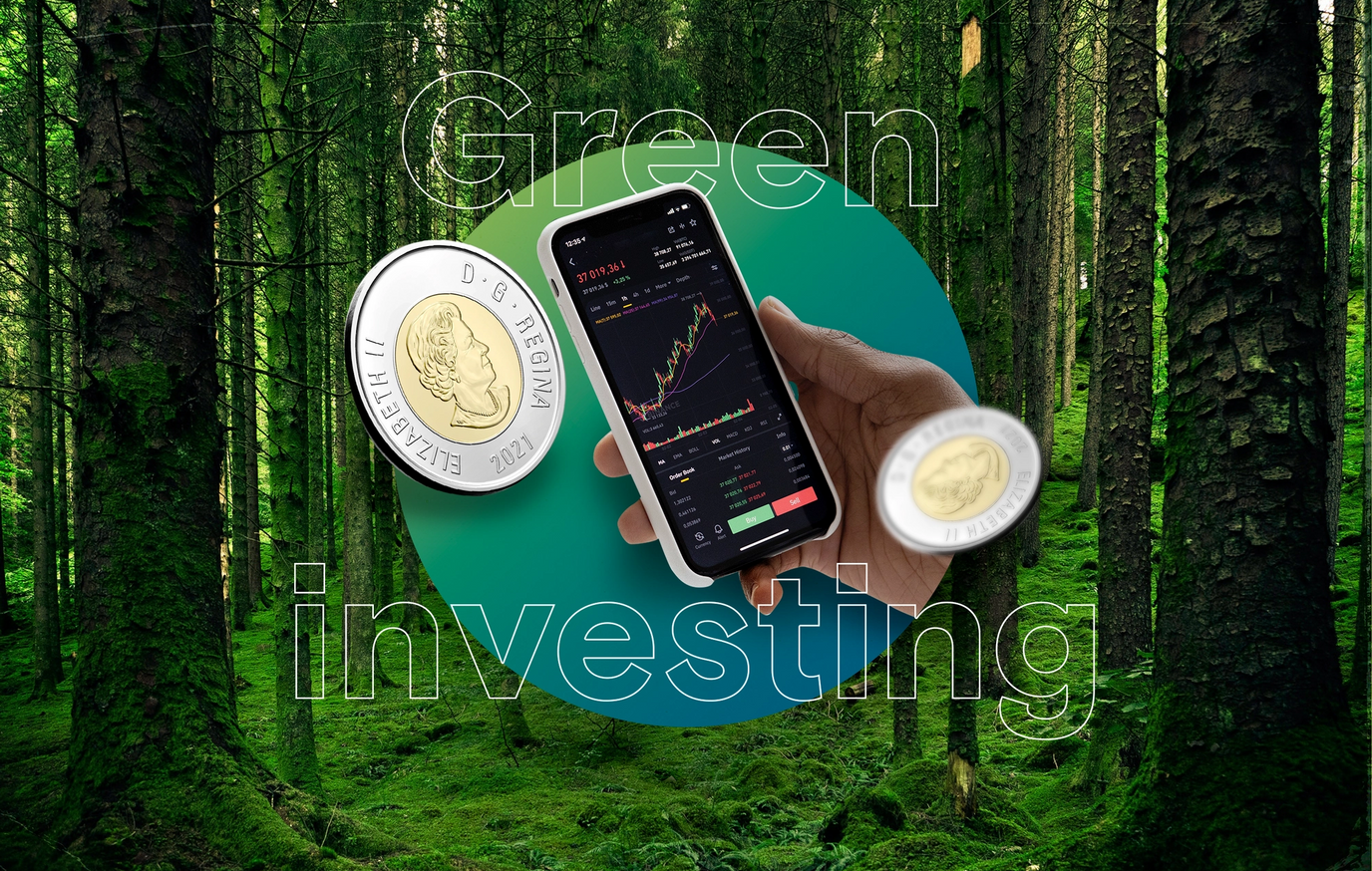Back
What is green investing?
8 min read

Written By
Gaby Pilson
Rounding it up
Green investing is the act of investing money into companies that have eco-friendly practices and sustainable business models.
Anyone can get started with green investing with a brokerage account or a retirement account.
Green investments come in many different shapes and sizes, so you can find the investments that fit your values and financial goals.
You want to put your money to work and maximize your savings. Great, consider investing some of your spare cash; there are plenty of profitable and exciting companies out there. But wait, you’re also concerned about how environmentally conscious these companies are.
So what’s an investor like you supposed to do?
Do you invest in companies in the hopes that they help you turn a profit, even if they harm the planet in the process? Or do you seek out investment opportunities that put the environment at the forefront of their business model?
If investing in companies that align with your eco-conscious values sounds like something you’d like to get involved with, then we have good news for you: green investing.
What is green investing?
Green investing, or eco-investing, is the act of investing your hard-earned money in companies that are committed to environmentally friendly and sustainable business practices.
Depending on who you ask, what constitutes a “green investment” can vary.
For some folks, green investments are investments in any company that has eco-friendly policies and practices driving their day-to-day operations and future growth. Meanwhile, others argue that a company can only qualify as a green investment if it’s directly involved in environmentally beneficial products or services, like renewable energies or compostable materials.
Regardless of how you define green investing, the concept is clear: a green investment should have a positive impact on the environment. As a result, green investments are a popular choice among people who want to align their financial life with their eco-friendly values.
SRI, ESG, and green investing: what’s the difference?
We should mention, however, that while green investing is often lumped together with socially responsible investing (SRI) or environmental, social, and governance (ESG) investing, it’s technically not the same thing.
That’s because SRI and ESG investing also focus on supporting companies that make quality choices with regards to human rights, social justice, and the like. While those same companies might also practice environmentally friendly policies, that might not be the only reason that you choose to invest in them.
To be clear, green investing could be considered a type of SRI and ESG investing. But instead of focusing on a wide range of companies with positive social benefits, green investors stick solely to companies with environmentally beneficial policies and products.
SPEND SMARTER. SAVE FASTER
Advantages and disadvantages of green investing
Green investing might sound like a great way to put your money where your mouth is, and for good reason: buying green stocks and other assets is a superb method to financially support companies that uphold your environmental values.
But all investments come with pros and cons, and green investing is no exception. To get you started, here are some important benefits and downsides of environmentally conscious investing that you ought to consider:
Advantages of green investing
Provides support for eco-friendly companies – As an individual, it can sometimes feel like you don’t have a lot of power when it comes to effecting positive environmental change. But, by investing in eco-friendly companies, you can help directly and indirectly encourage companies to make good decisions for the planet.
Helps finance new environmental innovation – Our world faces a whole host of challenges as the climate changes. Dealing with these challenges requires a lot of financial resources, and investing in eco-friendly companies can help support companies that want to develop new green technologies.
Offers potential for long-term growth – Renewable energies and other eco-friendly products and services are well poised for long-term growth as countries around the world look to mitigate the effects of climate change. This means that a small investment in a green company now could literally pay dividends down the line.
Disadvantages of green investing
Comes with the potential for short-term losses – Although there is quite a bit of hope that green investments will be financially lucrative in the long term, they might not be as financially successful as other companies in the short term. Since eco-conscious companies won’t compromise on their values for an economic boom, green investments may result in losses or only modest gains in the near future.
Finding green investments is challenging – While many companies think that slapping some green packaging on a product is enough to qualify them as an eco-friendly organization, it’s far from reality. That could make it more difficult for you as the investor to find quality green investments. You often have to do a lot of research to figure out if a company is truly committed to positive environmental policies and action.
Company practices and policies can change – It’s always important to remember that a company’s policies and practices can change at any time, and not always for the better. A new CEO or influence from stakeholders can cause a company to abandon its green strategies, dragging the ethical value of your investments down with it.
"Green investing, or eco-investing, is the act of investing your hard-earned money in companies that are committed to environmentally friendly and sustainable business practices."
How to get started with green investing
Now that you understand what green investing actually is, it’s time to talk about how you can start investing like a pro without compromising on your values. Let’s walk you through five steps that you can take to make green investing a part of your savings and budgeting strategy.
1. Open an investment or retirement account
If you want to start green investing, the very first thing you’ll need to do is to open a dedicated investment or retirement account.
While your standard chequing or savings account is a great tool for handling day-to-day transactions, they aren’t designed to hold stocks or other investment assets. So, you’ll need a purpose-built brokerage account to get you started.
Canadians have access to a range of different brokerage accounts. These include traditional non-registered accounts, like tax-free savings accounts (TFSAs), which are perfect for people who want to invest for non-retirement goals. Alternatively, a registered retirement savings plan (RRSP) is an ideal choice if you’re looking to save for later in life.
Regardless of what type of account you open, what’s important here is that you have a brokerage account at the ready to help you start investing.
2. Research green investment options
As soon as your brokerage account is up and running, it’s time to start researching different green investment options.
Unfortunately, there’s no one-stop-shop resource out there that can help you narrow down your list of potential investments. That means that you’ll have to do your own research when it comes to figuring out which of the more than 1,500 companies listed on the Toronto Stock Exchange (TSX) align with your environmental values.
One of the easiest ways to invest in green companies, however, is to focus on firms that explicitly work in sectors like renewable energy. There are plenty of Canadian and international renewable energy companies on the TSX, so you’ll be able to find at least a few that work well for your investing strategy.
If you want to move beyond investing solely in renewable energy, you’ll likely need to do even more research to narrow down your options. Doing so can be tricky because you need to have a detailed working knowledge of an industry to truly know if a company really does uphold its stated environmental claims.
Alternatively, if you’re not interested in researching and buying individual green stocks, you could opt for sustainability-focused exchange-traded funds (ETFs) or mutual funds, instead.
Both ETFs and mutual funds bundle together stocks, bonds, and other assets into one tradable security that you can buy on the TSX. Some ETFs and mutual funds have special themes, like sustainability or clean energy, so they can be a relatively quick and easy way to get started with green investing.
3. Purchase eco-friendly stocks, ETFs, and mutual funds
Once you’ve identified the green stocks, ETFs, and mutual funds that you want to have in your portfolio, it’s time to make your first investment purchases.
Every brokerage handles trades slightly differently, but you’ll likely be able to place a buy order for the stocks, ETFs, and mutual funds of your choosing online during market open hours. Once your assets are in your account, you can sit back, relax, and watch as your money goes to support environmentally friendly companies and your bottom line — all at the same time.
SPEND SMARTER. SAVE FASTER
4. Monitor your investments on a regular basis
At this point, you have a portfolio complete with green stocks, ETFs, or mutual funds at your disposal.
But your investing journey isn’t over once you place your first trades. Rather, you need to stay up-to-date on market trends and the value of your portfolio on a regular basis.
Of course, this isn’t to say that you should start getting nervous and sell off your investments whenever there’s a whiff of a market downturn. Experienced investors know that making money through stocks and other securities is usually a long-term pursuit, so you should leave your assets in place as long as you can to help them grow.
With that in mind, you will want to regularly check up on your investments to ensure they’re still working in your interest. If a company has been on a downward financial spiral for a while, it might be time to mix things up and invest your money elsewhere, such as in a green-focused company that’s about to make its IPO.
5. Make frequent investments to help grow your portfolio
As we’ve mentioned, investing is a long-term pursuit. This means that you should plan to buy and hold your assets for at least a few years at a time to increase your chances of turning a profit.
Along those same lines, you should also make a plan to frequently add funds to your brokerage account.
Regular investments, either into the securities that you already hold or into new assets, can help you take advantage of long-term market trends. Whenever possible, you should also try to add new green stocks, ETFs, and mutual funds to your portfolio to help diversify your assets and lower your risk of financial loss.
In fact, even relatively small contributions to your investments, such as the funds you might make off of RoundUps and cash back each month, can go a long way toward building up a financial nest egg down the line.
Go green!
Making money through investments and caring for the planet don’t have to be mutually exclusive activities. With green investing, you can maximize your savings and support companies with positive environmental impacts all at the same time. What could be better?

About the author
Gaby Pilson is a writer, educator, travel guide, and lover of all things personal finance. She’s passionate about helping people feel empowered to take control of their financial lives by making investing, budgeting, and money-saving resources accessible to everyone.
Read more about this author